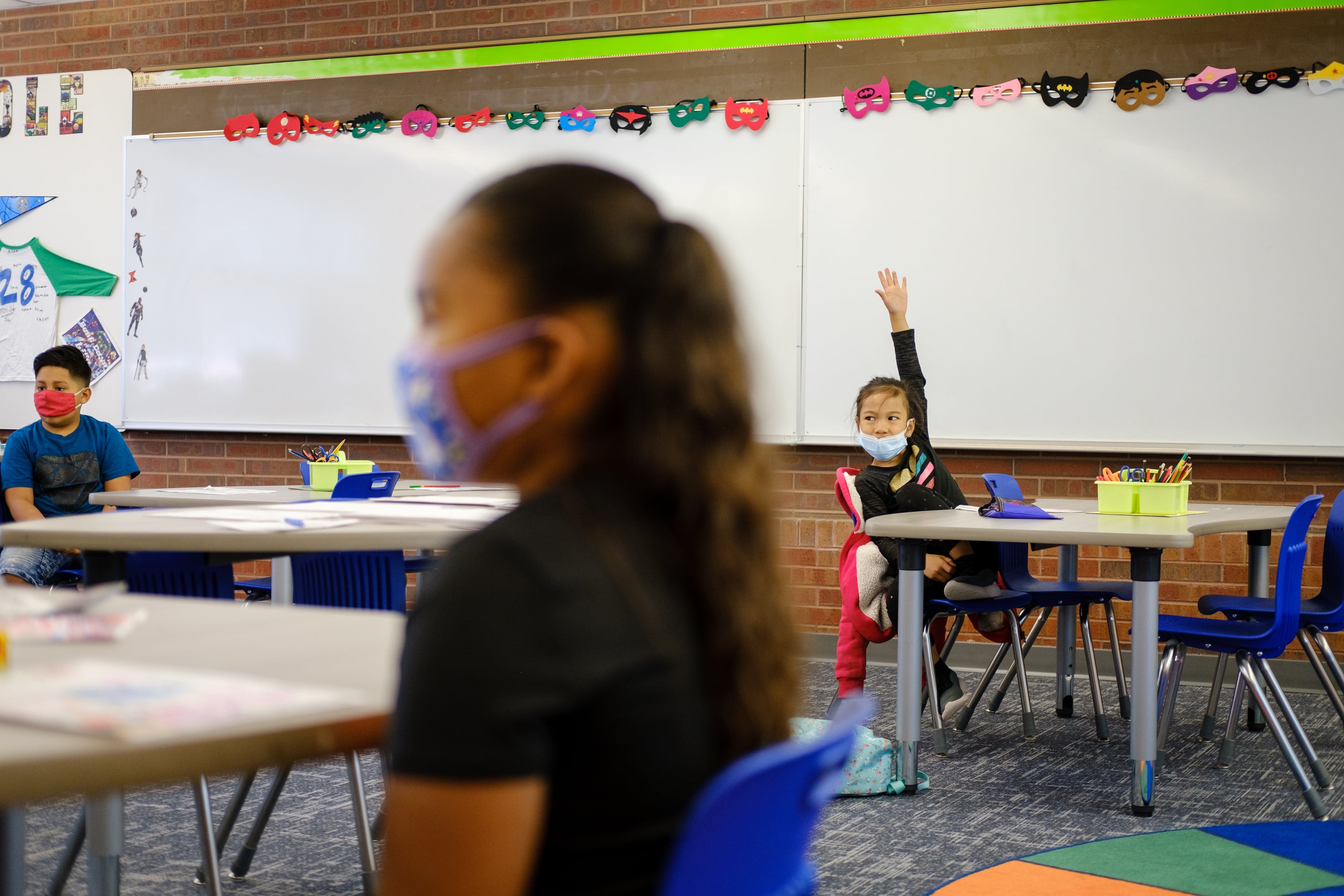Colorado has released district- and school-level results from spring standardized tests known as CMAS that give a more detailed picture of student achievement during a deeply disrupted school year, but with participation rates varying widely and little information on how much time students spent in the classroom, that picture is hard to bring into focus.
One thing is clear: Many students struggled academically last year. Statewide, scores were down for most grades and subjects, especially for students from low-income families, Hispanic students, and those learning English. Similar patterns are evident in many districts’ test data.
Officials with the Colorado Department of Education said this year’s CMAS results should not be used to compare schools and districts to each other and should be interpreted cautiously.
“I would encourage folks to be very focused on their local communities,” said Joyce Zurkowski, chief assessment officer for the Colorado Department of Education.
Scores declined in districts that spent much of the fall in remote learning, but also in ones that prioritized in-person learning. Students in some districts and schools posted gains despite the challenges, with school leaders saying they were able to use federal dollars to provide extra instruction.
In communities where participation was high, the results should give a reasonably accurate picture of how well students grasp grade-level concepts. Where participation was lower, it matters whether the students who took the tests are representative. If scores went up but participation went down, did students benefit from smaller class sizes or better instruction? Or did only the best test-takers take the test?
Testing experts caution that participation lower than 80% makes results hard to interpret, especially for subgroups.
Participation ranged from as low as 11.4% of sixth graders who took the math test at Colorado Connections Academy, an online school based out of the suburban Mapleton district, to 100% of fourth graders who took the math test at Grandview Elementary in Windsor.
“From a statewide perspective, we can have a reasonable level of confidence in our results,” Zurkowski said. “When it comes to our schools and districts, there is great variation in what that looks like. Those schools and districts with high participation will be able to utilize those results at a group level much more than schools and districts with very low participation.”
Students took fewer tests after a turbulent year off
The tests given in spring 2021 were significantly scaled back from 2019, the last year students took any standardized tests.
Colorado students in grades three through eight typically take literacy and math tests known as the Colorado Measures of Academic Success, or CMAS, along with either a science or social studies test. This year, in a compromise between testing supporters and those who wanted to cancel the tests entirely, students in grades three, five, and seven took the literacy test, while students in grades four, six, and eight took the math test. Eighth graders also took the science test.
High school students took the PSAT or SAT as usual.
In some communities, there were active campaigns to discourage families from taking the test, while in others, families with safety concerns kept their children home. There was no option to take the tests remotely.
Cañon City in southern Colorado had participation rates above 90% on many tests, which Superintendent George Welsh attributes to keeping school doors open all year and emphasizing the value he sees in the tests. But it would be a “farce,” he said, to use the data to compare schools and districts.
“The least value I’m getting is how we compare to the rest of the state,” he said. “The best value I’m getting is how Johnny Jones did in third grade reading at Cañon Exploratory School.”
Young readers at Cañon Exploratory and two other district elementary schools posted gains — in some cases substantial ones — while scores declined at two other schools.
While the pandemic created significant hardship, federal stimulus dollars also provided new opportunities. At the start of the school year, Welsh wasn’t sure how schools would run reading intervention groups that brought together students from different classes.
“Thanks to a little extra money from federal stimulus and some creative budgeting, we had smaller intervention groups and more frequent ones,” he said. “And then in the spring, we extended the school day with reading intervention on a daily basis. Normally we couldn’t afford that.”
CMAS scores are only one piece of the puzzle
Testing advocates say the results are useful, but more data is needed about factors that impacted student’s access to learning last year.
In districts that made every effort to offer in-person instruction, some families may have been hesitant to send children to school consistently because of COVID worries, said Erica Manoatl, manager of research initiatives for the Colorado Children’s Campaign, which advocated for the state to administer CMAS tests. Likewise, in districts that relied more on remote learning, some students may have missed lessons because they lacked access to a computer or internet.
“There were instructional reach issues no matter what they decided,” she said.
Data on things like daily attendance and log-in frequency would give more insight, but it’s not clear whether the education department or another group can provide it, Manoatl said.
In addition, she said if key subgroups, such as Hispanic students, students from low-income families, and English learners, have participation rates under the 80%, it will be “tricky for us because those are the groups we want to understand.”
Even schools with low participation can use individual student results, along with other data, to get a sense of where that student sits academically as the new school year gets underway. Parents, too, can use their children’s results to understand their child’s academic progress and initiate a conversation with the teacher or principal.
“Parents are very familiar with what schools had to deal with in terms of remote instruction versus in-person instruction, technology and device access, what topics were covered,” Zurkowski said. “A parent who had a child in fourth grade before might know that their younger child didn’t get all the topics that a child would normally get in fourth grade.
“Parents should have conversations with their child’s teacher and schools and districts. How are you going to use these results, along with other sources of data, to address what seems to be incomplete learning?”
The Colorado State Board of Education has said that it wants to use $132 million in federal relief money as well as state money for intensive tutoring in ways that reach the students who were most affected by the pandemic and that focus on core skills in math and reading. Rhonda Haniford, associate commissioner of school quality and support for the state education department, said that as schools and districts apply for money to make up for lost learning, their CMAS scores will be one piece of evidence of their students’ needs.
“We are prioritizing the funding where the most needs are, and that would include taking a look at the state assessment data,” Haniford said, adding that, “$132 million is a lot of money and at the same time there are a lot of needs.”
Colorado is not issuing school ratings this year, and no school will be placed on the performance watch list or see its rating lowered due to test scores. However, schools that have been on the list could use scores as part of an argument for getting out from state supervision.
Scores declined in many districts
Scores declined in Colorado’s largest school district, Denver Public Schools, where only about half of eligible students took the tests this year. The state’s second-largest district, Jeffco Public Schools, also saw decreases, though not as steep. A higher percentage of Jeffco students took the tests, with some grades seeing more than 80% participation.
Both Denver and Jeffco started last school year remotely. Elementary students in both districts had some in-person learning in the fall — Jeffco much more than Denver — before going virtual again after Thanksgiving and then returning to in-person learning for the second semester.
Scores in Denver metro area districts that had more in-person learning don’t paint a cohesive picture. Some went up, some went down, and some stayed steady. In the Cherry Creek School District, more third graders scored at grade level on literacy tests in 2021 than in 2019, but fewer sixth graders did in math. Participation rates in the Cherry Creek district, where the superintendent was a vocal opponent of standardized testing, ranged from 32% to 62% depending on test and grade level.
Scores dropped precipitously in the Adams 14 district, which was ordered by the state to turn over most day-to-day operations to an outside manager because of its persistently low test scores. Whereas 21% of third-graders scored at grade-level or above in literacy in 2019, only 11% did this past spring. Students in Adams 14 were remote for most of last school year. Even when schools reopened in the spring, more than half of students opted to stay virtual. Participation rates ranged from 20% to 56% depending on test and grade level.
Find complete state results here.
Search our database to find participation rates and scores in third-grade literacy and sixth-grade math participation for Colorado schools.
The Colorado Department of Education redacts results for students groups 16 or smaller, as well as additional data points to further protect student information.








